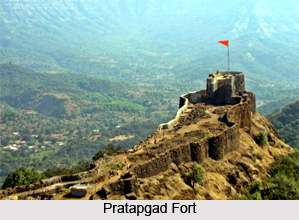 Pratapgad Fort is an ancient hill fort built by Chatrapati Shivaji.It is located 24 km West of Mahabaleshwar crowning the summit of a hill which is 3543 feet above sea level. The Pratapgad Fort is the site of a historic episode between Shivaji and Afzal Khan, leading to a most decisive turn in the course of the history of the Marathas.
Pratapgad Fort is an ancient hill fort built by Chatrapati Shivaji.It is located 24 km West of Mahabaleshwar crowning the summit of a hill which is 3543 feet above sea level. The Pratapgad Fort is the site of a historic episode between Shivaji and Afzal Khan, leading to a most decisive turn in the course of the history of the Marathas.
Partapgad was the stronghold of Shivaji, founder of the Maratha Empire. In 1659, it was the scene of his notorious, treacherous encounter with Afzal Khan, the Muslim general of Bijapur, who was decoyed to his death under a flag of truce. Shivaji seized the general and disembowelled him with a fearsome weapon known as a baghnakh or `Tiger`s claws` (steel claws attached to the fingers) concealed in his closed hand before routing the bewildered Bijapur troops.
The Pratapgad fort was built in 1656 by Shivaji in order to control the rebelling Satraps of the Javali Basin surrounding the area. The Fort comprises a double line of fortifications guarded by corner bastions. It consists of two forts- an upper fort which is built at the top of the hill and, another one, the lower fort, lying immediately below on the south-east. Considered to be impregnable, its massive walls, projecting towers and bastions and iron-studded spiked gates, rendered it one of the strongest hillforts in the Deccan region. To the west and north are sheer precipices which, in places, have a vertical drop of 800 ft. To the south and east are towers and bastions about 40 ft high above a steep scarp of black rock. A branch road leads to the foot of the fort and from here a steep path of 500 steps leads to the summit. From a distance, the fort gives the appearance of a round topped hill.
The simple Tomb of Afzal Khan lies below the fort on the crest of the hill. It is covered by a pantiled roof. There is also a Bhavani temple situated near the fort. A ruined palace of the Peshwas lies to the south-west. It was struck by lightning in 1817.
The Pratapgad fort was a very tightly guarded one. It was a maze of chambers, ponds and long dark paths, some of them leading to trapdoors that led to a 100 metre fall. All this made Pratapgad one of the most formidable forts in the Deccan region.



















